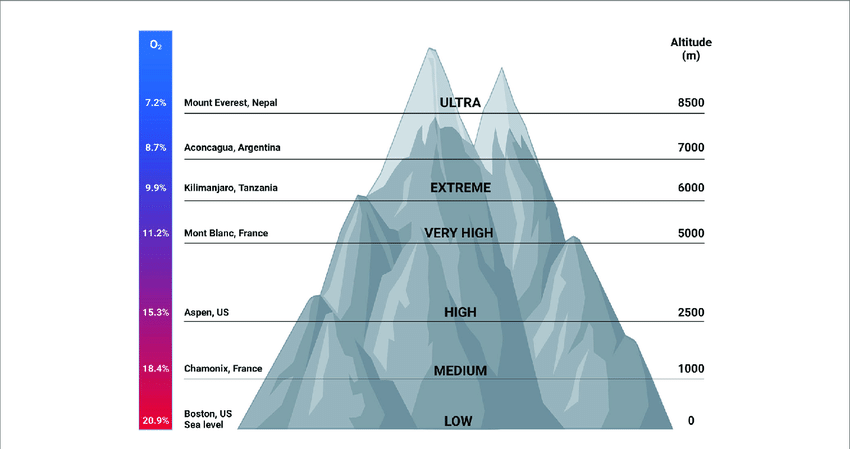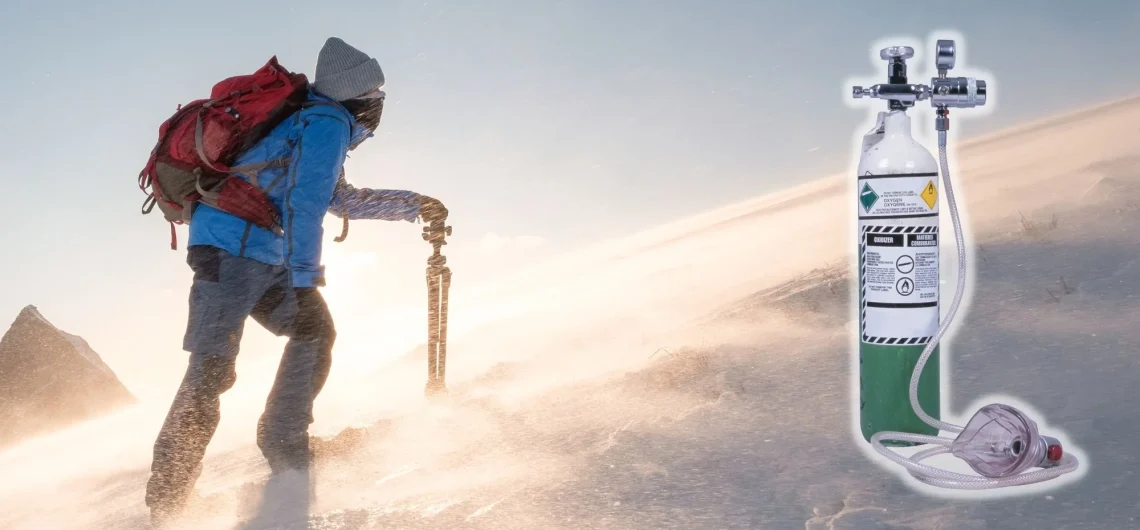Is supplemental oxygen necessary when climbing Kilimanjaro? The air at all altitudes contains a constant percentage of 21% oxygen. However, the number of oxygen molecules varies due to changes in air pressure. At sea level, the air is compressed, causing oxygen molecules to be closer together and making the air denser. However, at higher altitudes, the air pressure decreases and oxygen molecules spread out, resulting in thinner air. This decrease in oxygen at higher altitudes leads to altitude sickness or acute mountain sickness (AMS). Symptoms of altitude sickness typically start at around 8,000 feet and become more severe as you climb higher. The exact cause of AMS is not fully understood, but it is clearly related to a lack of oxygen (hypoxia) and other factors such as physical exertion and individual susceptibility. Altitude sickness, particularly AMS, is the primary cause of fatalities during Kilimanjaro climbs. High-altitude pulmonary edema and high-altitude cerebral edema are two serious forms of AMS that can be fatal on the mountain. To be prepared for emergencies, many Kilimanjaro operators carry oxygen to treat climbers who develop moderate or severe altitude sickness. Tranquil Kilimanjaro always carries oxygen for emergency purposes on every climb. This oxygen is only used in critical situations to aid a distressed climber during immediate descent. It is not administered on a regular basis but is part of the rescue and evacuation process. While some operators may advertise the use of a “personal oxygen system” to assist climbers on Kilimanjaro, this is not a standard practice.
You do not need supplemental oxygen to climb Kilimanjaro.
Supplementary oxygen is typically reserved for extremely high altitudes above 23,000 feet, as heights exceeding 26,000 feet are inhospitable for extended human existence, also known as the ‘Death Zone.’ Kilimanjaro’s peak measures 19,341 feet, making the use of supplementary oxygen exceedingly uncommon there. It is important to note that there are valid reasons why utilizing oxygen in this manner is strongly discouraged, aside from the fact that it may give the impression of being a patient in a hospital rather than a mountain adventurer. When an individual experiences moderate to severe symptoms of altitude sickness, it is not simply an unpleasant experience created by the body without purpose. Rather, it is the body’s way of acknowledging that the climber is incapable of functioning effectively at the current altitude and wants to discourage further ascent. The body is sending a clear message: STOP CLIMBING. Failing to heed this warning is the primary cause of trouble for most people while on the mountain.
Despite being clearly instructed to either maintain or decrease altitude, the importance of using oxygen while ascending loses its significance.
By using additional oxygen, a mountaineer effectively disrupts the natural process of acclimatization in their body by increasing the oxygen levels in the air they breathe. This reliance on supplemental oxygen delays or even halts the body’s ability to adjust to low-oxygen environments. As a result, the body no longer feels the need to make necessary adaptations for surviving in such conditions since the supplemental oxygen creates an environment rich in oxygen. Moreover, while the body fails to acclimatize to the current altitude, climbers who rely on oxygen make matters worse by ascending to even higher altitudes. This dependence on oxygen for one’s well-being poses a hazardous situation. Furthermore, what is the purpose of climbing Kilimanjaro with supplemental oxygen? The true challenge of Kilimanjaro lies in its altitude. As a hiking endeavour, it becomes less challenging if one eliminates the high altitude factor. Although some individuals climb Kilimanjaro merely for the sake of bragging rights, regardless of the method employed, it does not hold much significance as an accomplishment if the mountain’s altitude is disregarded. And this is precisely what supplemental oxygen achieves. Ultimately, the use of supplemental oxygen is potentially perilous when attempting to climb higher, completely unnecessary on Kilimanjaro, and goes against the essence and difficulty of conquering the mountain. Oxygen is not a requirement for reaching the summit of Kilimanjaro and its use should be avoided.
We carry emergency oxygen on Kilimanjaro and medical kits on all climbs.
The high altitude of Kilimanjaro presents a considerable challenge for climbers. However, it is not necessary to use supplemental oxygen in order to reach the summit. Instead, climbers employ the acclimatization method, which involves walking slowly and gradually ascending to higher altitudes while sleeping at lower altitudes. Spending more days on the mountain increases the likelihood of successfully reaching the summit of Kilimanjaro. To ensure safety, our climbs are equipped with supplemental oxygen tanks and oxygen masks.
Should you use Supplemental Oxygen on Kilimanjaro?
Bottled oxygen is not provided to climbers experiencing low oxygen levels or breathing difficulties to aid their ascent to the summit. This approach may hide signs of a more serious condition and later lead to altitude-related issues. Despite the existence of tour operators or companies that promote the use of a “personal oxygen system” for Kilimanjaro climbers, it is crucial to note that this method is not recommended. Apart from the fact that it would make one resemble a hospital patient rather than a hiker, there are significant explanations for why utilizing oxygen in this manner is discouraged.
What is the point of climbing Kilimanjaro with supplemental oxygen?
The challenge of Kilimanjaro primarily lies in its high altitude. In terms of hiking difficulty, it is not particularly challenging unless you take into account the extreme elevation. Some individuals may climb Mount Kilimanjaro solely for the sake of boasting about it, regardless of the method chosen. However, if Mount Kilimanjaro were placed at sea level, it would greatly diminish the achievement.
Our Guides Administer Oxygen on Kilimanjaro in Emergency Situations Only
When a climber is experiencing severe symptoms of Acute Mountain Sickness (AMS), we resort to using an oxygen mask to provide additional oxygen and quickly alleviate symptoms, enabling them to safely descend to a lower altitude. In the case of High Altitude Cerebral Edema (HACE) or High Altitude Pulmonary Edema (HAPE), the only solution is to descend as rapidly as possible. Our team will accompany you throughout this descent and we are prepared with an emergency stretcher, in case an injury or medical condition prevents you from walking. While oxygen can provide temporary relief, the only safe options for trekkers with symptoms of AMS, HACE, or HAPE are to either refrain from climbing higher, thus forfeiting the summit attempt, or to descend.
What about the Western Breach?
Climbers who choose to embark on the Western Breach route, known for its challenging descent and limited options for stretcher evacuation, will encounter various difficulties. In the event that a trekker exhibits symptoms, it is possible for us to administer oxygen (and/or dexamethasone) to enable them to safely ascend to the rim of the crater. This will be followed by a swift descent through Stella Point. This raises the question: If climbers on Everest utilize oxygen masks, why do they not do the same on Kilimanjaro? Interestingly, the summit of Kilimanjaro sits at a similar altitude as Everest Base Camp. However, oxygen is commonly used on Everest in the “death zone” above 26,000 ft, where acclimatization becomes impossible. If one were to rely on oxygen while attempting to summit Kilimanjaro, it could potentially mask symptoms of altitude sickness and disrupt the natural adaptation process.
Correlation of altitude and oxygen concentrations
The correlation between altitude and oxygen concentrations is a fundamental aspect of high-altitude physiology. As altitude increases, the concentration of oxygen in the atmosphere decreases due to the lower air pressure. This reduction in oxygen availability can have significant effects on the human body, particularly at high altitudes where oxygen levels are significantly lower than at sea level.

At sea level, the atmospheric pressure is higher, resulting in a higher concentration of oxygen molecules in each breath we take. As altitude increases, the atmospheric pressure decreases, causing a decrease in the partial pressure of oxygen. This means that with each breath taken at higher altitudes, the lungs receive less oxygen.
The decrease in oxygen concentration at higher altitudes can lead to various physiological changes in the body as it tries to adapt to the reduced oxygen availability. These changes include an increase in ventilation (breathing rate), an increase in heart rate, and an increase in the production of red blood cells to help carry oxygen more efficiently to tissues.
At extremely high altitudes, such as those encountered during mountaineering expeditions or in the case of altitude sickness, the reduced oxygen levels can lead to hypoxia, a condition characterized by inadequate oxygen supply to body tissues. This can result in symptoms such as shortness of breath, fatigue, headaches, nausea, and even more severe complications if not addressed.
![]()


Comments